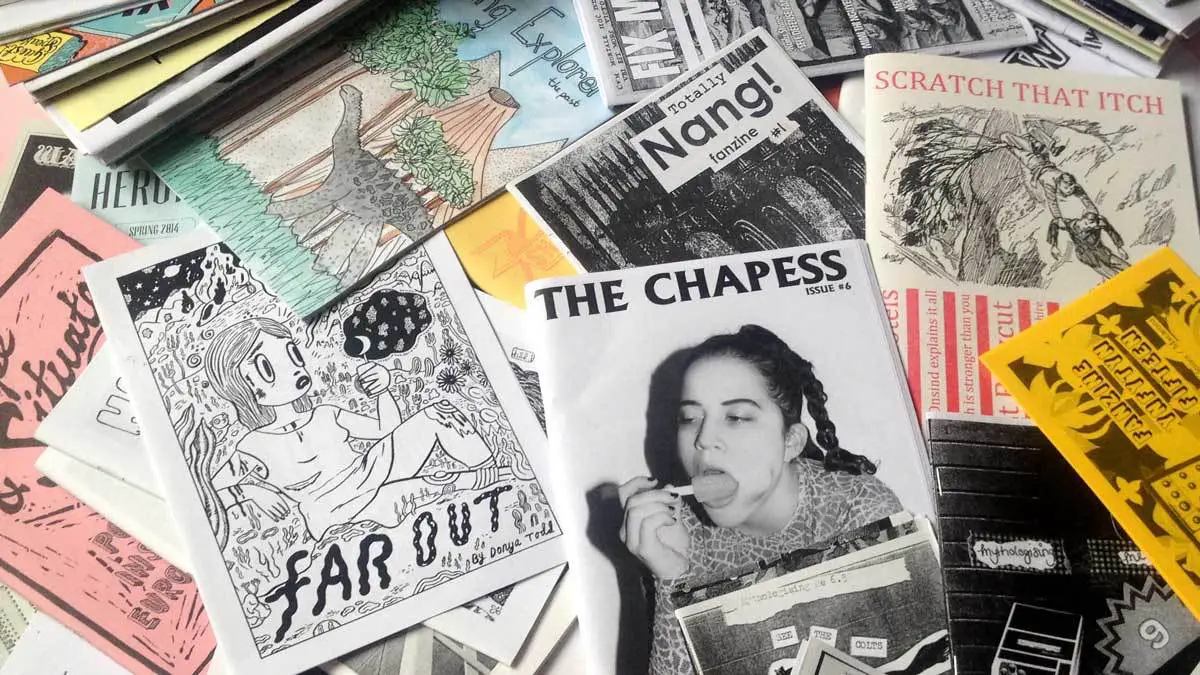Praise the Zine
Millennials are pushing deeper into zine culture, developing pamphlets promoting social justice, relevant movements and even just art and poetry.
By Kristian Porter, Northern Kentucky University
In a society built on profit, deadlines and marketability, art and writing can start to feel stifled and contained.
Censorship runs rampant in the media, and some people can start to feel hopeless in their efforts to share their creativity with the world. Enter zines, the creative outlet that advertises complete freedom.
I learned about zines a few months ago in a YouTube video by Ariel Bisset, and since then, I’ve started seeing mentions of them everywhere. In order to satisfy my curiosity, I decided to do a little research of my own, and now I’ve fallen in love.
Zines are reflective of the culture they are born in and are important, now more than ever.
So, What Are Zines?
According to the Zinewiki, a zine is an independently published booklet, usually created by only one person (though that’s not always the case). They aren’t made for a large audience like a traditional magazine; instead, only a select number are printed and circulated, because they often deal with controversial or niche subjects. Zines are completely self-funded and are usually only sold to make up for the cost of production, often leaving the creators at a deficit.
But it’s not about the money, it’s about the message. Zines are made because someone has something they need to say, and they don’t have a platform to speak on any other way. The great thing about these self-published magazines is that anyone can create them.
How Did It All Begin?
The word zine is derived from fanzine, a publication distributed amongst a particular fandom, which trace all the way back to Science Fiction publications in the 1920s. Zines evolved out of their nicheness, and since then have become associated with protests, movements and minority voices.
The punk scene in the ‘70s is usually attributed to the rise in zine culture, as they were used to promote bands that didn’t receive a lot of mainstream attention. The name “punk” is actually the result of the first known zine by Legs McNeil, “Punk,” which covered the New York arts and music scene in 1975.
Then, in the 1980s, the concept of zines as an art form was solidified when Mike Gunderloy created “Factsheet Five.” He catalogued and reviewed every zine that was sent to them, creating a network for creators.
The feminist movement, particularly Third-Wave Feminism, has strong ties to zine culture. The riot grrrl movement used zines to publish content that otherwise would not have been seen. They discussed sexuality and body image, as well as sexual violence, assault and abuse. The zines focused on personal experiences, not shying away from or censoring the gritty details. Erika Rienstien, founder of Riot Grrrl Press, said, “Because every time we pick up a pen, or an instrument, or get anything done, we are creating the revolution. We are the revolution.”

Zines were instruments of protest and change, and they continue to be.
Many people thought that, with the creation of the internet, zines would meet their end, but in the last decade, zines have seen a resurgence in interest.
Why Do They Matter?
In a time of such political tension and untrustworthy news sources, zines are more important than ever. Those whose voices are often overshadowed—minorities, LGBT, women—need to have an outlet where they can still reliably be heard. When someone like Donald Trump calls for a dynasty like “Saturday Night Live” to be censored because he doesn’t like the parody of him, it can create an environment of fear.
But, as Rookie Magazine said, “Zine-making isn’t about rules or knowledge; it’s about freedom and power.”
Zines are an exercise in your freedom of speech, in your fundamental right to be heard.
Whether you’re a Nasty Woman looking for a place to submit, or a person of color looking to publish, there are zines looking to be your platform.
And zines can be anything—a collection of poetry, artwork, photographs, a bunch of magazine clipping or a combination of all of the above. There is no limit to what you can create, and no one to tell you that you can’t.
On top of that, zines are an incredible testament to the longevity of print as a journalistic medium. Yes, many zines have found themselves a home online, as either a full-fledged website or a scanned copy of the physical product. It’s an easy way to reach an audience you never could have had before.
However, many zines are still made the old fashioned way: some paper, art supplies and a photocopier. They are printed and distributed to close-knit groups or at rallies or meetings. Physical copies are passed around and a conversation is started and, by word of mouth, a movement is spread.
As someone who has a love for language and literature, it’s beautiful to watch words and artwork inspire and affect so many people.
How Can You Get Involved?
If you’ve found yourself itching for your voice to be heard, there are plenty of places looking to publish you. But, like I said before, zines are so great because they can be made by literally anyone. If you can’t find the exact publication you’re looking for, or you just want to make something that is wholly your own, put together a zine yourself!
It’s as simple as folding some paper and letting your creativity flourish. Splatter paint on it, write words haphazardly across the page, photograph everything. You can write about cats or “Doctor Who” or the ways media is suppressing black voices. There are no rules and no limits.
And when you’re done, share it with someone. It can be your friends, your family, your book club or strangers on the internet. Whomever it may be, let them hear what you have to say. Then, inspire them to participate in the zine culture as well. The more voices that are heard, the more people will be able to understand another’s experiences and the better society will be.












[…] Read about how why zine culture is so important: http://studybreaks.com/2016/12/14/the-resurgence-of-zine-culture-and-why-its-so-important/ […]
[…] The Resurgence of Zine Culture and Why Its So Important – studybreaks.com […]
[…] while ago, when I was still writing for Study Breaks, someone wrote an article about the power of zines and why they are so popular nowadays. In fact, the internet is a good way to deliver a message and […]
[…] the past few years, we have seen the resurgence of zine culture. In Toronto, there are multiple zine fairs held throughout the year such as Zine Dream, OCADU […]
[…] Porter, Kristian, THE RESURGENCE OF ZINE CULTURE AND WHY IT’S SO IMPORTANT, Study Breaks, 14 Dec 2016, https://studybreaks.com/2016/12/14/the-resurgence-of-zine-culture-and-why-its-so-important/ […]
[…] I lost track of zines. It was fantastic to learn the other night the art form is experiencing a resurgence and a new generation is stepping out of the mainstream and finding refuge in something that is not […]
[…] https://studybreaks.com/2016/12/14/the-resurgence-of-zine-culture-and-why-its-so-important/ […]
[…] Kristian, 2016 — The Resurgence Of Zine Culture And Why Its So Important, https://studybreaks.com/2016/12/14/the-resurgence-of-zine-culture-and-why-its-so-important/ […]
[…] https://studybreaks.com/culture/the-resurgence-of-zine-culture-and-why-its-so-important/ […]
[…] In this recent post, The Resurgence of the Zine Culture, the writer makes a strong case for zines returning popularity. […]
[…] Zines began as a DIY form for small, but dedicated fanbases. The goal was to make information that was hard to find in mainstream sources as widely available as possible, often at low to no cost. Though the form began in the 19th century, it found a critical mass among science fiction enthusiasts of the 1930s and was also popular among the DIY punk movements of the 1970s and early 1980s as well as the independent/underground music scenes of the early to mid-1990s. […]
[…] Zines began as a DIY form for small, but dedicated fanbases. The goal was to make information that was hard to find in mainstream sources as widely available as possible, often at low to no cost. Though the form began in the 19th century, it found a critical mass among science fiction enthusiasts of the 1930s and was also popular among the DIY punk movements of the 1970s and early 1980s as well as the independent/underground music scenes of the early to mid-1990s. […]
[…] Zines began as a DIY form for small, but dedicated fanbases. The goal was to make information that was hard to find in mainstream sources as widely available as possible, often at low to no cost. Though the form began in the 19th century, it found a critical mass among science fiction enthusiasts of the 1930s and was also popular among the DIY punk movements of the 1970s and early 1980s as well as the independent/underground music scenes of the early to mid-1990s. […]
[…] https://studybreaks.com/culture/the-resurgence-of-zine-culture-and-why-its-so-important/ […]
[…] When we create content that speaks to a highly targeted audience, it’s very powerful. The reach is much smaller, but the resonance is much greater. We’re not just firing off any piece of content to anyone in the area. We’re creating something personal, something authentic tailored towards a very niche audience. This best practice replicates the zine culture. According to an article describing the merits of the Zine culture: […]
[…] Coming to a resurgence in the 1970’s documenting the palpable but mostly unreported punk subcultures of New York (in fact, the word ‘punk’ is taken from the title of a 1975 zine by Legs McNeil about the bands in the New York scene), the self-publication and potential for unheard perspectives and insights was integral to zines’ popularity. The 1980s and 1990s queercore and riot grrrl movements are closely associated with a vibrant zine culture, as is much of third-wave feminism, highlighting the form’s effectiveness for communicating radical ideas from marginalised positions. Erika Reinstein, founder of Riot Grrrl Press, echoed this sentiment – “Every time we pick up a pen, or an instrument, or get anything done, we are creating the revolution. We are the revolution.” (Porter, 2019) […]
[…] Once all the rage in the punk culture of the 1970s, zines have made a comeback in the new millennium, and it’s easy to see why; just about anyone can create their own self-published magazine. Including yourself! Before setting off to create your own zine, make sure you have something to say – zines are all about the message. From there, it’s up to you what to include; poems, photographs, art… Let your creativity fly!Once you’ve put scraped together your own little zine, make sure to find the best place to sell your work. As zines are often highly personal, your own social media can be a great place to start. Just remember; you probably will not make a living out of selling zines, but it can be a great way to let the world see your creative talents and network with other artists (and make a little bit of money, of course)! […]
[…] Джерело […]
[…] Джерело […]
[…] © Study Breaks […]